You’re going to Rome and plan to stuff your face with all the foodie goodness. But there are literally tens of thousands of restaurants and a whole slew of unwritten cultural rules for eating and drinking.
So how can you make sure that you avoid the tourist traps and get the most out of your time eating in Rome?
We’re Jana and Brett. Back in 2017, we lived here in Rome and we’ve been back nearly every year since then and also have dual Italian citizenship.
And during our time in Rome, we have learned so much about the food culture in Italy, particularly the dos and don’ts of how, when, and where to eat in Rome.
Rules are made to be broken, especially in Italy, so you’ll find exceptions to just about everything on this list.
But our goal today is to teach you these rules about coffee, gelato, markets, and meal times so you can pass the tourist test and eat like a local in Rome.
Prefer to watch? Join tens of thousands of other viewers on our YouTube channel!
#1 | Don’t expect a big breakfast
Plenty of Italians skip breakfast, but for those who do eat something, it’s often small and on the go. So don’t expect a Waffle House style breakfast or a continental spread with eggs and bacon and toast (or baked beans for our British friends).
Here, a common breakfast eaten on the way to work is an espresso and a cornetto, which is a croissant.
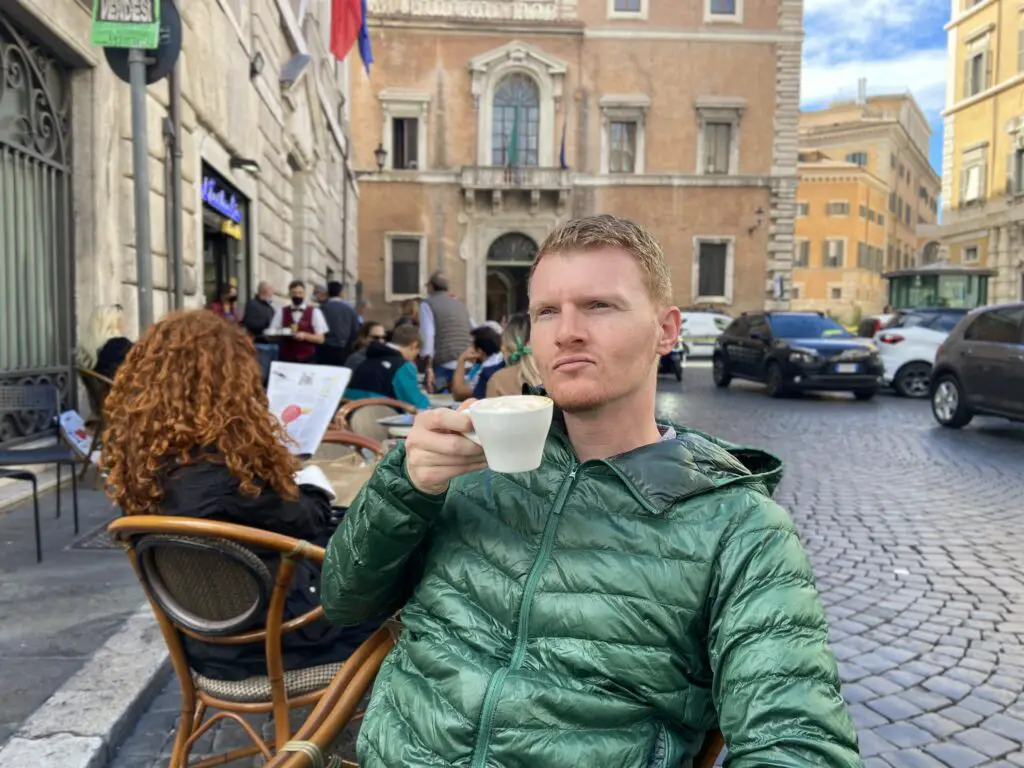
#2 | Forget about that large cuppa coffee
Speaking of espresso, this or a cappuccino is the drink of choice for most Romans in the morning. No one here gets a cup of coffee. It literally isn’t even on the menu in most places!
If you want something more like that cuppa Joe that you’re used to, ask for a caffè Americano. It’s espresso with water added to it.
But you didn’t come all the way here to order American style coffee! So ditch that Americano and get some of that beautiful Italian espresso.
#3 | Order coffee like a pro
Sometimes names are misleading, and this is especially the case with coffee in Rome. For example, if you ask for a latte, you’re going to get a glass of milk and probably a confused look, too. What you’re actually wanting is known as a caffè latte here in Italy.
And a macchiato, that’s just an espresso with a dollop of milk foam on top.
Now, a caffè, that’s just simply an espresso, which is basically like a normal coffee here.
And while we’re on the topic of names, the place you go for coffee is not a cafe. It’s actually a bar. And this was a really interesting experience because when we lived here, we volunteered at the local high school and we often went to the bar with high school students to hang out and have a coffee!
#4 | Get your coffee at the bar (and how to order it)
Coffee just isn’t something that Italians tend to linger over—maybe the size of their coffee has something to do with it. It’s still something they enjoy socially, but perhaps not in the way you’re accustomed to.
There’s not really a culture for sitting down and having coffee with someone. They might come into the bar with colleagues or chat with the barista. But the whole experience is over in about 3 minutes compared to 30.
You should know that the process for ordering in most bars goes something like this:
- Walk in and go to the cash register, which is called a cassa.
- Order what you want, pay, and get a receipt.
- Take your receipt to the bar and hand it to the barista.
- Wait for your order, then enjoy at the bar!
And just like that, you’re ready to drink coffee and eat breakfast like an Italian.

#5 | Don’t eat lunch near the main tourist sights
When you’re walking around the main tourist attractions you’ll notice tons of restaurants with menus written in English and with waiters out front inviting you in for a meal. Skip this tourist trap by going just a few streets from those sites, or by venturing into one of the neighborhoods just outside the center of Rome.
In fact, finding a restaurant without an English menu is usually a good sign that it’s pretty authentic. But if you want a really good sign, see if you can find a restaurant that only has the menu written by hand on a chalkboard.
#6 | What is Italian food?
Okay, once you find a restaurant in Rome, you’re probably wondering what is typical Italian food? Well, that’s probably not what you think. It’s not fettuccine alfredo, Italian salad dressing, pepperoni pizza, or chicken parmesan. Those are all really good American Italian dishes, but not typical Italian food.
- Instead of fettuccine alfredo, try cacio e pepe. It’s a local pasta dish made with pecorino cheese and black pepper.
- In lieu of salad dressing, opt for just classic oil and vinegar. I know it sounds really boring, but trust me, the olive oil here is so delicious.
- And pizza is a great quick lunch when you’re in Rome. But if you order a pepperoni pizza, you’re going to get a pizza with bell peppers. That’s because in Italian, pepperoni actually means bell peppers. So what you’re really wanting to order is a pizza with salame.
#7 | Be careful about having a late lunch
You don’t realize how enamored you are with Rome’s history and monuments until it’s 2 o’clock and you’re just now thinking about lunch. Well, too bad. Typically, lunch ends around 2 or 3, and then most of the good restaurants are closed. So if you make the mistake of delaying for a later lunch, you might miss your opportunity altogether.
If that does happen to you, don’t worry. You’ll always find pizzerias and bakeries open in the afternoon. Just don’t aim for a sit down lunch.
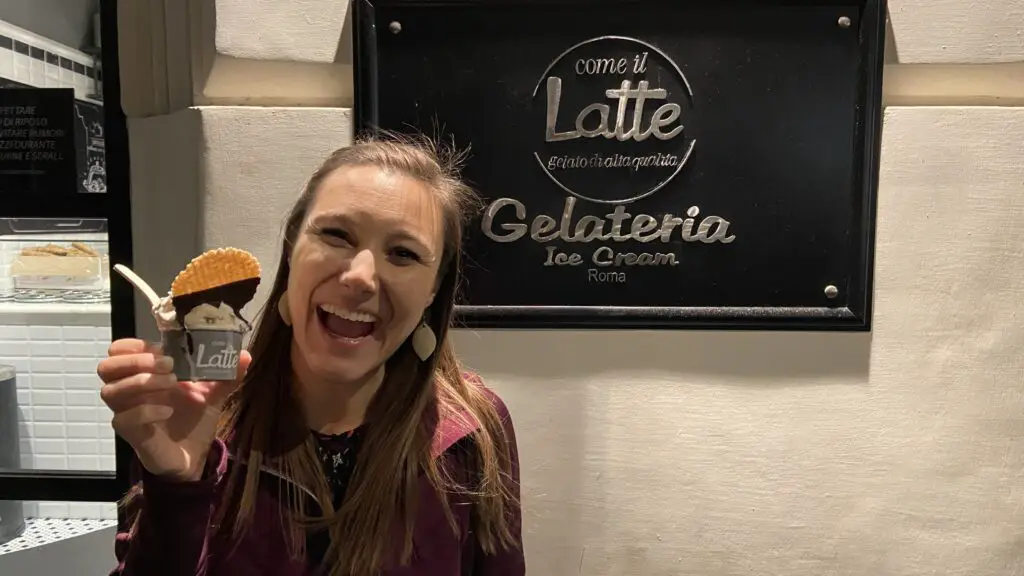
#8 | Know your “-erias”
Okay, this is one of my favorite things to do any time we’re in Rome—or really any time we’re just in Italy, for that matter. And I call it Eye Spy the “-eria.” Here’s what I’m talking about:
- Pizzeria
- Caffeteria
- Osteria
- Spaghetteria
- Pasticceria
- Gelateria
- Trattoria
- And so many more!
And while we’re on that topic, a pizzeria or an osteria are great places to get a good, affordable local lunch in Rome.
If you spy more -erias, drop them in the comments below! I love to expand this fun list 🙂
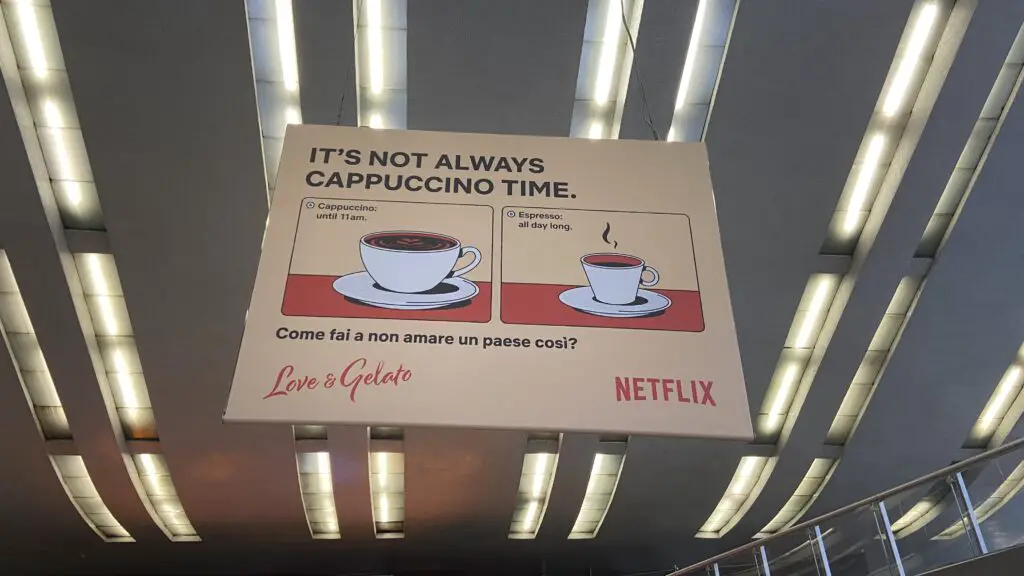
#9 | Skip the cappuccino after lunch
An Italian cappuccino is a morning drink. The idea goes that milk doesn’t go well with heavier foods, and especially not in the heat of the day. While I understand their reasoning, it kind of makes me wonder why it’s okay to have gelato in the afternoon?
All questions aside, if you want to look like a tourist, order a cappuccino in the afternoon.
Sometimes I do this just because I want one, and it’s fun to see how they react. But if you want to fit seamlessly into the Italian coffee culture, stick to espresso in the afternoon.
#10 | Hands off the produce!
If you’re European, you probably already know this, but if you’re American, this is really important to know in Rome—and really kind of in Europe in general.
There is a particular type of etiquette and manners when it comes to food markets and grocery stores.
The first thing to know is that you do not touch the produce when you’re in a food market. You actually pick what you want, tell the vendor, they will grab it for you, weigh it, and give it to you. So hands off the produce.
And in grocery stores, the cashier actually does not weigh the produce for you when you check out. You have to do that yourself.
- Put on a plastic glove and grab a plastic bag.
- Then grab the produce you want and put it in your bag using your gloved hand.
- Next, make note of the number on the sticker for that type of produce.
- Go over to the scale and place your bag on the scale, type in the number, and then put the sticker on the bag.
- And that’s how the cashier will ring up your produce.
If you don’t follow these rules, you will probably have somebody scold you—ask me how I know! So learn from our mistakes and instead of doing a trial-and-error, now you know how to go shopping for produce at a market or grocery store when you’re in Rome.
We hope you’re already feeling more prepared to eat like a local! If you’re thinking, “Wow, I wish I knew that sooner!” then join our newsletter! We promise to only drop into your inbox with useful tips, info-taining videos, and relevant travel content!
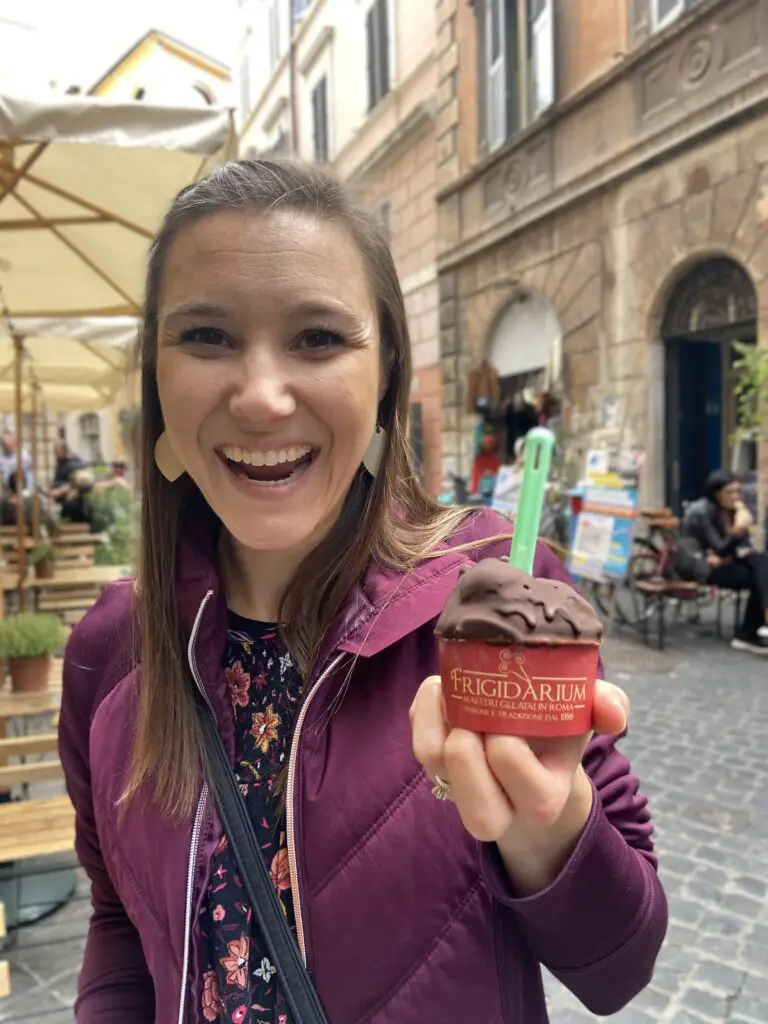
#11 | Don’t eat bad gelato
One of the worst mistakes you can make in Rome, in my opinion, is having bad gelato. Unfortunately, bad gelato actually exists, and you may not only realize it until you’ve had truly great gelato. So today I’m going to help you avoid that mistake.
First, they say you should not judge a book by its cover, but you should absolutely judge your gelato by its cover. Like literally, if it’s covered.
Authentic gelato is often stored in metal tubs with these metal lids on top to keep it temperature controlled. But the places where you just see these mounds and mountains of gelato sitting out typically have added ingredients to keep it from melting, and you want to avoid that.
Next, look for gelaterias that are called artigianale. This just means they use high quality milk and sugar. And again, these ingredients just give you this pure, incredible gelato flavor.
And while you’re scoping out a place, pay attention to the colors of the gelato, too. You might be attracted to the bright, vibrant colors, but in reality, fresh, authentic gelato has a more muted color tone than you would think. For example, pistacchio isn’t as green as you would expect, and a berry flavor usually isn’t as neon either.
Lastly, follow the locals. There are tons of gelaterias in the city of Rome and some of the ones in the touristy areas are actually pretty good.
But when in doubt, just follow the locals. Especially if it’s in the middle of the afternoon or late at night after dinner, they’ll take you to the right place.
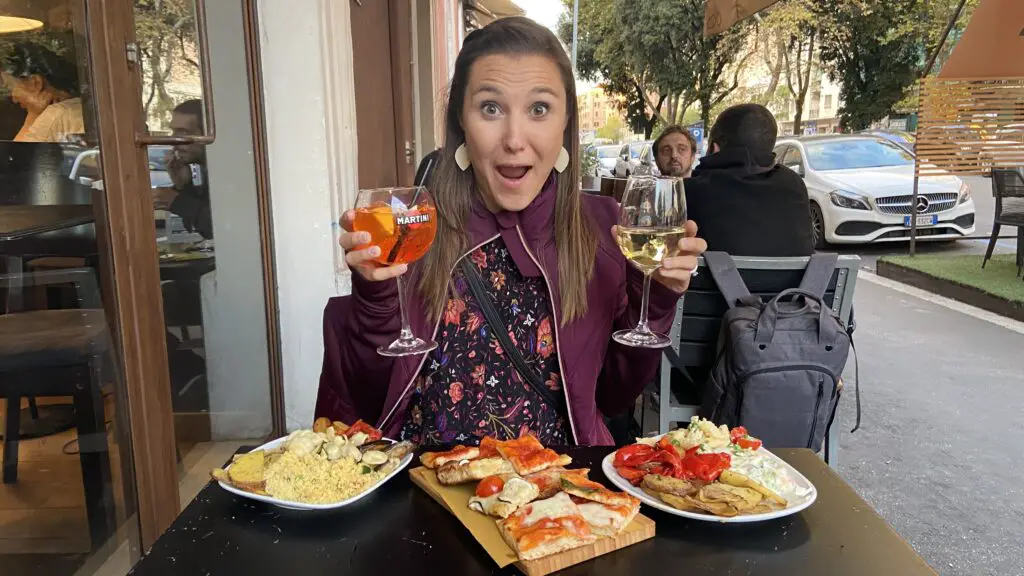
#12 | Enjoy aperitivo
Being a tourist is hard work. After all of that walking and sightseeing and selfie taking, you’re going to be pooped before the sun even sets. And it would be a mistake to not take advantage of aperitivo.
After work and before dinner, lots of restaurants open for aperitivo. This is a cool cultural experience where you order a drink and get appetizers for free. Lots of people like to order an aperol spritz, which is orange bitters mixed with prosecco. But you’ll also find that beer and wine are popular here, too.
As for the food, it ranges from small plates of pizza and breads all the way up to an entire buffet spread that’s practically like a meal. And if you’re like us, this might be enough to be your dinner.
#13 | Expect a late dinner
In reality, dinner begins around 7:30 or 8:00pm. Now we know that’s way later than the standard 6:00 in the U.S. but when in Rome, do as the Romans do.
Actually, if you find a restaurant that opens before 7, it’s probably catering to tourists and likely doesn’t provide the authentic Roman food that you’re actually hoping to taste. Which is also another reason why aperitivo is so clutch.
#14 | Make dinner reservations
Romans often make dinner reservations so they can secure a table at their desired restaurant. And that’s not just because Rome is a popular touristy city, but that makes sure that they can have the table for the entire night.
Yes, that’s right. When you go to a restaurant here in Rome, you get the table for the whole night, for hours and hours of a leisurely meal.
In fact, our longest meal that we’ve ever had in Italy lasted for four and a half hours. And that’s because of the Italian meal structure.

#15 | Understand the Italian meal structure
Ahh, the Italian meal. It’s an art form in its own right. From the fresh vegetables to the handmade pastas to the perfectly paired wines, every aspect and ingredient of these meals are made to be savored. And if you understand how Italian meals are structured, you’ll come back to eat in Italy again and again.
Here’s an overview of the courses available in most good Italian restaurants.
Antipasti. These are like your starters or your appetizers.
Primi. The first course, which are usually pasta dishes.
Secondi, which are usually meat or fish dishes. And now the primi and secondi together make up what we typically in America call entrees.
Then you have the contorni, which are side dishes and usually don’t come with the primo or secondo. You’ll have to order those separately if you want them.
Then, of course, come the dolci, which are desserts.
After which you can have a caffé, which is an espresso.
And then if you’d like, you can have one of the digestivi. Normally these will be amari, which are bitter liqueurs, or a limoncello or some other type of liquor.
It’s important to know that most people don’t enjoy every course in one single meal. Sometimes they’ll have an antipasto with a primo or secondo, and then sometimes they’ll just have a primo or secondo and no antipasto. Sometimes they’ll have dessert. Sometimes a digestivo. But they pretty much always have an espresso. 😉
While a dinner with all of these courses is usually reserved for a special occasion, we think you should try it at least once on your trip to Rome. So show up hungry, enjoy the evening, and savor the whole experience.

#16 | Order Italian wine
If you want to make an Italian waiter angry, come to Italy and order a French or American wine. No, there’s technically nothing wrong with it, but you’re in Italy and this entire country is literally overflowing with good wine at insanely great prices.
Imported wine will always be more expensive, so don’t simply ask for what sounds familiar. Unless it’s Italian wine, of course! In fact, the best deals can be had by just asking for the house wine. Sometimes the price of the house wine is so low, it’s literally cheaper than a bottle of water.
#17 | Slow service does not equal bad service
If you haven’t seen your waiter or waitress in the last half hour, don’t worry. In Italy, they don’t hover over your table and continually question if you like your food or ask if you want a drink refill—which also isn’t really a thing here.
If you need something, don’t be afraid to flag down your waiter or waitress, but otherwise just enjoy the privacy and linger at your table.
And when you’re ready to pay for the bill, you simply ask for “il conto, per favore,” which means “the bill, please.”
#18 | Don’t be surprised by the coperto/cover charge
No one likes to see a surprise charge on their bill, and you might be surprised to end your wonderful Italian dinner by being greeted by a charge known as the coperto.
The coperto is basically a cover charge, often 2 or sometimes 3 euro per person. You’ll normally see this written on the menu if the restaurant charges the coperto, but don’t assume automatically that it’s a tourist trap or a rip off if they do. And definitely don’t go and berate the waitstaff if you didn’t notice this charge until you received your bill.
You can see how easy it would be to make lots of mistakes while eating in Rome. In fact, we made this video because there are plenty more mistakes that tourists make that have nothing to do with food. Watch that next so you can eat like a local and act like a local on your trip to Rome!


